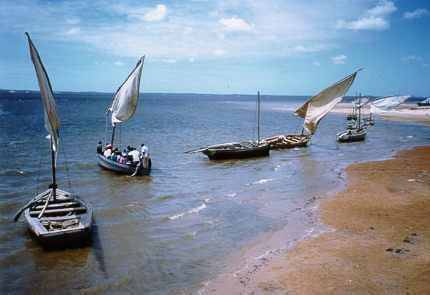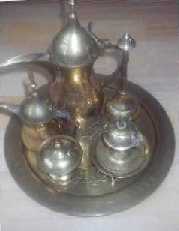
The Waswahili Community Trust UK
(Wadhamini wa jumuiya ya Waswahili)


|
The Waswahili Community Trust UK |
 |
If there is one pursuit that links all the Swahili peoples, that pursuit is fishing. Fishing is an endemic way of life of all Swahilis from time immemorial. The Bajunis illustrate this cultural trait in full abundance. Consistent with their ecology, Bajuni fishing is primarily a littoral fishing utilizing the leeward side of the coral reef that stretches virtually along the entire Swahili coast from Mogadisho in Somalia to Maputo in Mozambique. Practically all the fishing done by the Swahilis is within this zone.
While the Swahilis in general and the Bajuni in particular are familiar with ocean-going vessels, they are not really open water fishermen. Indeed, few fishermen (worldwide) venture into open waters' fishing without the technology of cold storage.

Near the shore, bulk fishing of single species at appropriate seasons has been associated with subsidiary sun-drying (much less, smoking) industries. In the case of sharks, rays and kingfish (Scomberomorus spp), the northern waters from Somalia to Arabia constitute rich fisheries.
Dried fish are sold all down the East African coast and have, for centuries, constituted a staple source of 'potted' protein not so much for the Swahilis (who use a fair amount) but particularly for the immediate hinterland peoples (who depend upon them much more extensively). Papa, kipungu and nguru are favourites but various forms of dried fish that go under the general term of ng'onda are regularly utilized by both Swahilis and non-Swahilis.
With Swahilis they represent an occasional culinary adventure because preference is generally for fresh fish. But for certain dishes, it is normal to use dried fish. In all Swahili areas, however, there are times of very poor fishing and as such dried fish become a significant even if not a major source of supplementary protein.
But let us also remember that the Swahilis do not have a particular disapproval of animal meat. Indeed, mutton (usually goat meat) and beef are regularly consumed as part of the culinary orchestra of the Swahilis.
These come into more regular use during the kusi (southwest monsoon) season that is notorious for poor fishing. But these practices are becoming things of the past in many urban areas with the general availability of mains electricity, industrial cold storage facilities dedicated to fish freezing and domestic fridges and freezers.
Given these broad fish limitations, the Bajunis illustrate the range of Swahili fishing activities. There is fishing in the small vihori either singly or in pairs. These normally are within the main reef barrier but are quite opportunistic. At most times, the pair of fishermen would probably be using a fishing line. But at other times, the pair might be using a cast net to catch simu and dagaa.
In a larger dau, one would see a group of seven or eight fishermen going out to lay gill nets (majarife) in the outer reaches of the reef. The waters are deep and the fish big. But it is not for a single person or even a single pair of fishermen. You need several hands. Over centuries, a unique way of sharing out the proceeds of the catch has evolved.
It is uniquely Swahili and is still very much in practice among the Bajunis and, indeed, among the other Archipelago fishermen. After the fish have been sold, the proceeds are divided up equally between the fishermen but the vehicle captain gets an extra share. If the owner of the boat and the gear is among the fishermen, he also gets an equal share.
If he is also the captain, he also would get a captain's share. But whether he is part of the fishing crew or not, the boat also has an equal share and so has the fishing gear. This way everybody is satisfied that what God has given in the form of a 'daily fish' rather than a 'daily bread' has been shared fairly. This is the dau fishing.
Another type of fishing practised by the Bajunis is the uziyo fishing. This type of fishing is based on knowledge of fish behaviour that has yet to find its way into the fishing textbooks. The uziyo consists of a series of fitos strung together from the low water mark to the spring high tide mark.
It is shaped like an arrow. The 'arrowhead' is at the high tide end while the 'shaft' of the arrow goes out to the low water tide mark. As the tide comes in, a fish that touches the woven mat of fitos makes its way to the end. At the end, the fish finds itself within the uziyo head that is internally expanded. The fish will swim round and round in this arrowhead but somehow fail to find a way out.
At low tide, the uziyo owner and an assistant or two will go into the arrowhead and scoop out the fish. Because the uziyo head is at the spring high tide end, the fish keep alive and fresh even if sometimes a little stressed. It is relatively easy to describe the whole fishing procedure in a few sentences.ed. The fish will swim round and round in this arrowhead but somehow fail to find a way out.
The catching, however, is a very different kettle of fish as the expression goes. It is a skilled affair and one that requires years of patient tutelage! You see the fish are neither always docile nor readily willing to be recruited to the dinner table! One can step on an electric ray or an angry shark or, indeed, a highly venomous sea snake. These are the occupational hazards that the uziyo fisherman encounters daily!

We appeal for your donation for our charity
Comments and suggestions to improve this website
Your suggestions or concerns about our services
Please send you contributions using form to contact us .
| Thank you Asanteni |
|---|
Copyright© March 2003: The Waswahili Community Trust (UK)
Registered Charity:1083065